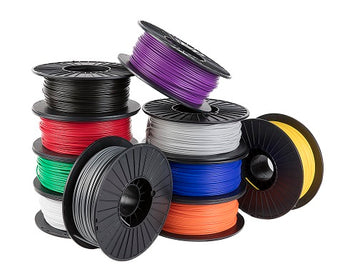Victoria Hand Project - Guest Post
Contributed by Alex Burden:

The Victoria Hand Project (VHP) is a not-for-profit company working to deploy 3d printed prosthetic hands to individuals in developing countries. By 3D printing the hand the costs are greatly reduced and it is now affordable to amputees in poorer countries. The project began as a Master’s project by the executive director of the project, Dr. Nikolai Dechev, while at the University of Toronto. The hand was ground breaking but it cost thousands of dollars to manufacture since it needed to be machined out of metal. The hand sat on the shelf until 2014 when an undergraduate engineering student at the University of Victoria, Joshua Coutts, suggested 3D printing the hand. Since then the hand has been deployed to over 70 people around the world, and 3D print centers have opened in 5 countries.

The VHP team develops and tests all of the designs at the University of Victoria, with the help of their arsenal of Ultimaker 3D printers, but sends the designs to developing countries to be printed there. A team member will travel to a country with two Ultimaker printers, a Next Engine 3D scanner, tools, and other hardware, and train the locals on how to fabricate a proper socket. By going into the country they are able to develop personal relationships with the workers, as well as oversee their first few fittings to ensure they have learned the process. The team also provides technical support from Victoria.



The hand has many features that make it more desirable over the other prosthetic hands. The biggest difference is the cost. A typical prosthetic device can cost a few thousand dollars, which is much too expensive for people in the developing world. The entire cost, including the material, hardware, paying the prosthetists, paying the technicians, and amortization of the 3D printers, is $300. The system includes a body-powered prosthetic hand, ball-and-socket wrist, custom forearm socket, and shoulder harness. The hand has something called adaptive grasp which allows the hand to conform around objects. Many prosthetic hands will “bottom out” when one finger makes contact with an object, but in the Victoria Hand the fingers other fingers can continue to close. The thumb is able to rotate to allow the user to use different grips. The wrist is able to rotate 360 degrees and allows the user to move the hand to different orientations. The socket is custom-made to a user’s forearm using 3D scanning. A trained prosthetist will create a plaster impression of the patient’s remnant limb to the custom socket. This plaster impression is then 3D scanner on a rotating table using the Next Engine laser scanner. This will create a mesh on the computer which will then be used to create a custom socket. The plaster impression is scanned rather than the patient’s remnant limb because the scanning process may take 10 minutes or longer and the patient would need to hold their arm completely still the whole time. A library of pre-made sockets, with different lengths, circumferences, and width adjusters, is given to the print centers. This whole process is completed in-country by technicians trained by the Victoria Hand Project team. The whole process of 3D printing the system takes around 40 hours and requires another day of work to assemble. An amputee can go into a clinic and have a new prosthetic device within a week.

Amputees in some countries also do not want others to know they have an amputation. They are ostracized and will not be able to find a job. This can lead their family into a life of poverty. The people who VHP have fit are very happy with the look of the hand. Other prosthetic devices, such as the split-hook mechanism, are not able to combine the functionality and cosmetics that the amputees want. The Victoria Hand has 5 fingers and is spray-painted to match the user’s skin tone.
The Victoria Hand Project currently has clinical partnerships and print centers in Guatemala, Cambodia, Nepal, Haiti, and Ecuador. The team has also fit one user in Egypt. Part of the reason VHP prints in country is to lower the cost and to provide local jobs. This also creates pride within the community. A technician can be paid a very good wage for 3D printing and assembling the hand. Many people in North America have been asking for the device to be distributed in North America, but as of now it has not been. The team says that if the device ever enters the North American market they hope to have workers at their print centers in the developing countries to create the hands and ship them to North America. This will keep the costs down while also providing more work for people in developing countries. 3D printing is becoming more common in humanitarian aid because many different devices can be fabricated in country using a 3D printer and a few rolls on filament. Some medical devices, such as casts or splints, can be heat molded to a person and provide the rigid support they require. The team is also working on other 3D printed medical devices to offer at these clinics.
The Victoria hand project is currently in the running for $750,000 of funding through the Google Impact Challenge. The project was chosen as a top ten finalist for the grant from over 900 not-for-profit companies across Canada. If VHP wins the top prize they will be able to provide 750 amputees across the world with hands, open print centers in five new countries, continue to develop their technology, and provide jobs around the world.
Vote for the project at victoriahand.com








